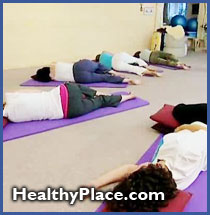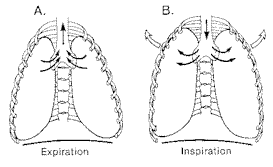Now you will learn three methods that are useful in learning the general skills of clearing the mind and calming the body. Read through each of these four sections below. Then choose among these three techniques for the one that best suits you.
- Cue-Controlled Deep Muscle Relaxation
- Generalized Relaxation and Imagery
- Meditation
- Which Works Best for You?
Home Study
- The Don't Panic Self-Help Kit, Section R: Practice Breathing Skills
- Tape 1A: Deep Muscle Relaxation
- Tape 1B: Generalized Relaxation & Imagery
- Tape 2B: Acoustic Meditation
- Don't Panic, Chapter 12. Releasing Tensions
Cue-Controlled Deep Muscle Relaxation
When a person thinks about a situation related to his anxiety, mental images activate the muscles into particular patterns of tension, as though bracing for a blow to the body. Dr. Edmund Jacobson was the first to propose that physical relaxation and anxiety are mutually exclusive. In other words, if one learns how to recognize which muscle groups are tense and can physically let go of that tension, then he will lower his emotional anxiety at that moment.
 This first exercise gives you an opportunity to learn how you personally experience tension, and then to change that tension. Called Cue-Controlled Deep Muscle Relaxation (CC-DMR), it is based on well researched and time-tested methods for training your mind to notice the subtle cues of muscle tension -- and to release that tension. CC-DMR, which takes approximately twenty minutes, trains your body's large muscles to respond to the cues you give. Your task is to consciously notice what muscle tension feels like in specific areas of your body and to consciously release that tension. Learning this particular technique is not essential to conquering panic. It is, however, one of the best ways to learn about your tension and how to alter it. If you have learned a different technique that produces these results, or if you have already mastered this skill, feel free to move on to the next sections of the book. When I teach a client this method, I give him or her a prerecorded audio-cassette tape with these instructions. For your convenience, you may purchase this prerecorded tape. I suggest that my clients practice the exercise twice a day, every day, for one weeks, then once a day, every day, for four weeks.
This first exercise gives you an opportunity to learn how you personally experience tension, and then to change that tension. Called Cue-Controlled Deep Muscle Relaxation (CC-DMR), it is based on well researched and time-tested methods for training your mind to notice the subtle cues of muscle tension -- and to release that tension. CC-DMR, which takes approximately twenty minutes, trains your body's large muscles to respond to the cues you give. Your task is to consciously notice what muscle tension feels like in specific areas of your body and to consciously release that tension. Learning this particular technique is not essential to conquering panic. It is, however, one of the best ways to learn about your tension and how to alter it. If you have learned a different technique that produces these results, or if you have already mastered this skill, feel free to move on to the next sections of the book. When I teach a client this method, I give him or her a prerecorded audio-cassette tape with these instructions. For your convenience, you may purchase this prerecorded tape. I suggest that my clients practice the exercise twice a day, every day, for one weeks, then once a day, every day, for four weeks.
Why so often for so long? Because this is a straightforward, mechanical exercise that physically trains the muscles to release their tension. At certain intervals during the exercise, you are asked to repeat a cue word, such as "loosen" or "relax." It seems to take about five weeks of practice before the physical loosening of the muscles becomes associated with that cue word. (You will be creating new "circuits" between your brain and your muscles.) Once that learning has taken place, the muscles will be prepared to release their tensions rapidly when that cue word is spoken (along with several other "cues" that I will mention later).
There are three stages to this twenty-minute exercise:
Stage 1: Tense and then relax each muscle group. You will be instructed to tense a particular muscle group for a few seconds, then release the muscles and allow them to loosen. (ten minutes)
Stage 2: Allow all the muscle groups to loosen and relax. (five minutes)
Stage 3: Support and reinforce the muscle relaxation through imagery. (five minutes)
How to do it.
Each day, find a comfortable and quiet place to practice. Take the phone off the hook or arrange for someone else to take calls. This a special time, just for you.
Begin by sitting comfortably in a chair; take off your shoes and loosen any tight clothing. Close your eyes and take three deep breaths, exhaling slowly. On each exhale, say the word "relax" silently. Or you may select a word that produces more comfort for you, such as "loosen," "quiet," "peace," or "calm."
First, you will tense and relax each muscle group once (Stage 1). During each relaxation phase, you will repeat the word "relax" (or your selected word) with every exhale.
Next you will follow in your mind a visual image of the sun warming and loosening all the muscles of your body (Stage 2). You needn't feel frustrated if you don't actually "see" the sun in your mind's eye, or "feel" the sensations of loosening or warming. It is essential, however, that you maintain your attention on each muscle group as it is mentioned and imagine the possibility of warmth and loosening of the muscles. You may be surprised at your growing ability over time if you don't try too hard. Just open your mind to the possibility of change.
During the last few minutes of the exercise you will be asked to "go to your safe place" in your mind's eye (Stage 3). Take a moment now to picture a scene that symbolizes comfort, relaxation, safety, warmth, and the absence of outside pressures. You might imagine yourself in some location where you were relaxed in the past: a vacation spot, fishing, sitting on a mountain top, floating on a raft, soaking peacefully in the bath, or lying on a chaise lounge in the back yard. Or you could choose to create an image of your ideal vacation dream (like your own private South Seas island) or fantasy (such as floating on a cloud).
Regardless of the image you choose, spend a few minutes developing all your senses within that scene. Look around you in your mind's eye to see the colors and patterns of the scene. Hear any sounds appropriate to the environment: perhaps birds singing, wind blowing, ocean waves crashing on the shore. You may even develop an aroma, such as honeysuckle or flowers, perhaps the salt air or the fresh odor after a rain shower. Enjoy all your senses in an easy, effortless manner. This is the kind of image you can use for your "safe place."
At the end of the exercise, open your eyes, stretch your body, and slowly rise from the chair. Several guidelines will help you as you begin:
1. The more you practice a skill, the greater your ability. So, be dedicated to this project and practice, practice, practice.
2. During the ten seconds of tensing, tense only the muscle groups described. Let the rest of your body be relaxed and loose.
3. Always continue breathing while you are tensing a muscle group. Never hold your breath while tensing.
4. During each fifteen-second relaxation phase, focus on your breathing and mentally say your cue word -- "relax" or "loosen" -- with each exhalation.
5. Don't evaluate or judge how well or how poorly you do during each practice. This is not a test. Simply practicing each day, no matter what you experience, will ensure progress. You are creating new, unconscious circuits in your brain. How you feel consciously is not a measure of your progress.
6. Some days you will find it quite hard to concentrate. Your mind will tend to wander to a variety of thoughts: "I've got to get back to my housecleaning." "What should I make for supper?" "This isn't working. I'm still tense." "I've got to remember to pay those bills." These kinds of distracting thoughts are normal; everyone experiences them. It does not mean that the process is failing.
As soon as you notice that you have drifted off course, let go of those distracting thoughts and return to your task. Do not feel angry or disappointed with yourself. Do not let that be a reason to quit the exercise. Your body and mind are still benefiting, still learning about control, still creating those new circuits. Stay with it.
7. You may do the exercise any time during the day or evening. It is best to avoid starting immediately after a meal, since your body is busy with digestion then and you are less alert mentally.
8. Do not expect immediate and magical relief from the practice. This process, repeated over time, trains your muscle groups to respond to a cue.
Some people will notice changes from the practice. You may find that you are more alert and rested, have an improved appetite and sleep better, are in a more positive mood and feel less overall tension. If any of these take place, consider them "icing on the cake." Your primary task is to practice every day for five weeks.
9. Some people have difficulty developing images to use during the "safe place" visualization at the end of the program. An alternative to the "safe place", called "One Hundred Counts", is presented in Chapter 14 of the self-help book Don't Panic.
Generalized Relaxation and Imagery
Some people find that a passive technique to quiet the mind and relax the body is more suited to their personal style. You will have two choices if you prefer a technique of this nature. One is called Generalized Relaxation and Imagery, and the second is a meditation practice.
In Cue-Controlled Deep Muscle Relaxation, you rely on tensing the muscles first as a way to experience relaxation. As an option, or for an occasional change of pace, you may want to try this twenty-minute Generalized Relaxation and Imagery exercise. In this practice you will focus only on relaxing -- not tensing -- your muscles. In addition, several new visual images are added to help you increase your sense of comfort and well-being as you enjoy peace and quiet. A pre-recorded tape is available.
Meditation
You may, after considering all three methods, prefer meditation instead of a relaxation technique as a way to release tensions.
Meditation is a family of mental exercises that generally involve sitting quietly and comfortably while focusing on some simple internal or external stimulus, such as a word, one's breathing pattern, or a visual object. In relaxation, the individual engages in a number of mental, and sometimes physical, activities. In meditation, the person is physically still and has a much narrower focus of attention.
There are a number of potential benefits to learning meditation, and I will explain them later in this section. These benefits fall within two general categories. First, meditation helps you to gain control of your physical tension by eliciting the Calming Response. Studies show that during meditation, as well as during relaxation, the heart rate and respiration rate slow down and blood pressure diminishes. Over time, meditators report feeling less daily anxiety, and they tend to recover more quickly after highly anxious times. Thus within this category, meditation and relaxation provide similar gains.
The second category of benefits offers the greatest distinct contribution to those who experience panic. Learning the skills of meditation can dramatically increase your ability to control your fearful thinking by teaching you new ways to respond to your automatic thoughts, emotions, and images. The typical panic-prone person dwells on his worries, pays close attention to fearful thoughts, and responds emotionally to his negative images. Instead of being in control of these experiences, he is controlled by them.
To learn to meditate is to learn how to step away from these experiences to become a detached, quiet observer of your thoughts, emotions, and images, as though you were watching them from the outside. Anyone who has experienced panic knows that the negative thinking during panic is so powerful that you can't simply say to yourself, "These thoughts are ridiculous. I am not about to die." That only invites a mental argument that increases panic: "Yes, I am about to die! My heart's racing a mile a minute. People die under this kind of stress."
Any type of self-change strategy requires as a first step the skill of self-observation. To reduce your anxiety reaction and halt your negative thinking, you must be capable of stepping back from them far enough to put them in perspective. Chapters 13 through 16 of Don't Panic will teach you how to gain that perspective and use it to control panic. This section gives you the foundation skills needed to implement those techniques.
There are two types of meditation that you may choose from. Since they each accomplish similar goals, you can practice either or both of them. The first is "concentration" meditation.
Concentration meditation
The four essential features of this meditation are:
- a quiet place
- a comfortable position
- an object to dwell on
- a passive attitude
How to do it.
Just as with the relaxation techniques, you should use a quiet place in your home or elsewhere to practice. Then, assume a comfortable body posture and begin to invite a passive attitude within your mind (meaning that you don't need to worry about or become critical of distracting thoughts -- you just note them, let them go, and return to the object you are dwelling on). The difference is that during meditation you select one object to focus on continually during the twenty minutes. You may choose a word (such as "calm," "love," "peace"), a religious phrase ("Let go and let God"), a short sound (such as "ahh" or "omm"), a feeling or a thought. You gently repeat that word or phrase silently at an easy pace. (For instance, if it is a one-syllable sound, you might say it once on the inhale and once on the exhale.) Or you may use your breathing pattern as the focus of your attention.
Both in meditation and in relaxation you are attempting to quiet your mind and to pay attention to only one thing at a time. An especially important skill to develop is that passive attitude. There should be no effort involved in the meditation. You pay attention to instructions, but you don't struggle to achieve any goal. You don't have to work to create any images; you don't have to put any effort into feeling any sensations in your body. All you have to do is remain aware, be in a comfortable position, dwell on the phrase, and easily let go of any distracting thoughts until those twenty minutes are over. That is the passive attitude.
A modification to this traditional "concentration" meditation, called "Meditation of One Hundred Counts", is presented in Chapter 14 of Don't Panic. It can help you remain mentally focused if you continue to be bothered by irrelevant thoughts. A second modification of this technique is a tape called "Acoustic Meditation", which provides pleasant sounds, timbers, patterns and rhythms to enhance your ability to concentrate.
Awareness Meditation
The second meditative technique is an "awareness" meditation. In concentration meditation, you dwell on one object and consider all other awarenesses as distractions. In awareness meditation, each new event that arises (including thoughts, fantasies, and emotions), becomes the meditative object. Nothing that rise up independent of your direction is distraction. The only distractions are the comments that you begin to have about what you see, hear or feel.
How to do it.
The process is as follows. Find a quiet place to sit comfortably for twenty minutes. Begin by focusing on your natural breathing pattern. Mentally follow each gentle inhalation and exhalation, without judgment and without comment. (Those who become anxious when attending to their breath may focus on a single word or sound instead.) After a few minutes, allow your attention to shift easily among any perceptions that rise up. As each new thought or sensation registers in your mind, observe it in a detached manner. As you observe it, give that perception a name.
For instance, in the first few minutes of meditation you are focusing your awareness on each breath. As you loosen your attention you soon notice the tension you are holding in your forehead muscles. Without effort or struggle, subvocalize a name of the experience -- perhaps "tension" or "forehead tension" -- and continue observing. Eventually, your perception will shift. As your detached observing mind follows your awareness, you take notice of a mental image of a man's face with the corners of his mouth turned downward. Do not become involved with the image: don't analyze its meaning or wonder why it appears. Simply notice it and name it -- "frown" or "man, sad face" -- while you maintain your uncritical perspective.
When you do become lost in your thoughts, involved in emotions or focused on a decision, return your full concentration to your breathing pattern until you regain your detached observer. Everyone gets caught up in their experiences from time to time during meditation. Don't be self-critical if you continually drift off and fail to expel those perceptions. In concentration meditation you merely relax, let go, and focus back on your meditative word. In awareness meditation you relax, let go, and follow the flow of your perceptions from a distance. What you observe is not important. How you observe is the key: without evaluation and without involved comments.
What You Can Learn from Meditation
You needn't become a skilled meditator to gain benefits from meditative practice. In fact, highly anxious people will find that the two relaxation techniques are easier to follow, and they may wish to choose one of those as a long-term method to relax their muscles and quiet their mind.
However, it is the process of practicing meditation that provides the valuable understanding that you can directly apply to controlling panic, even if you only practice the technique for several weeks.
Consider that during panic we become consumed by our momentary experience. We notice the unpleasant sensations in our body and become frightened by our interpretation of their meaning ("I'm going to faint," or "I won't be able to breathe.") We notice our surroundings and become frightened by how we interpret what we see ("There's no support here for me. This is a dangerous place right now.") We reinforce these sensations and thoughts by conjuring up terrifying images of ourselves not surviving the experience. Most of our thoughts, emotions, and images are out of proportion to reality.
To gain control of these moments we must become skilled at disengaging from our personal distortions.
We will not develop this skill by waiting until our next panic to practice. By then it's too late, because panic has control. The best time to learn a basic skill is during nonanxious periods. Then, we introduce that new skill gradually, over time, into the problem situation.
Here are the valuable lessons you can glean from meditative practice:
- Meditation is a form of relaxation training. You learn to sit in a comfortable position and breathe in a calm, effortless way.
- You learn to quiet your mind, to slow down the racing thoughts, and to tune in to more subtle internal cues. You acquire the ability to self-observe.
- You practice the skill of focusing your attention on one thing at a time and doing so in a relaxed, deliberate fashion. By reducing the numbers of thoughts and images that enter your mind during a brief period, you are able to think with greater clarity and simplicity about whatever task you wish to accomplish.
- You master the ability to notice when your mind wanders from a task, to direct your mind back to the task, and to hold it there, at least for brief periods. At first there may be a longer time span between when your mind wanders and when you realize it. With continued practice, you learn to catch yourself closer and closer to the moment in which you lose track of your task.
- Through meditation you desensitize yourself to whatever is on your mind. You are able to notice your personal fears, concerns, or worries and at the same time step back and become detached from them. In this manner you can learn about your problems instead of being consumed by them.
- If you regularly practice meditation and are able to feel more relaxed during that time, you gain the experience of mastery: your voluntary actions produce pleasurable changes in your body and mind.
- As you acquire the knowledge of how you feel when you are calm, then you can use that feeling as a reference point during your day. For instance, if you feel calm after meditation in the morning, you will have a greater chance of noticing the subtle cues of tension later in the day. In other words, meditation (as well as relaxation) helps you become more alert to what circumstances are stressful in your life. You then have time to intervene in your circumstances before your tension builds to uncomfortable proportions.
8. In the upcoming steps you will learn the importance of noticing your thought process leading up to and during panic. You must develop the sensitivity:
- to notice those thoughts,
- to then let go those thoughts, and finally,
- to turn your attention to some specific supportive tasks.
That is no simple feat! By practicing meditation you practice those three steps without simultaneously struggling with the frightening experience of panic.
9. Some people attempt to overcome the anxious thoughts leading up to panic by replacing them with positive thoughts. For instance, if they are thinking, "I'm about to lose control and go crazy," they will begin to simultaneously tell themselves, "no, I won't. I've never gone crazy before. I'll calm down soon." Sometimes this is quite a successful strategy. At other times, though, it can backfire by producing an internal quarrel. In arguments, of course, we tend to "dig in" to defend our position, and that's what can happen here: the fearful thoughts only get stronger. A central strategy you will learn in the coming steps is first to stop those fearful comments completely by shifting your attention to some neutral task. Then, after disrupting your fearful thoughts for a few seconds or a few minutes, you will be better able to introduce positive, supportive suggestions without risking the internal battle. The two meditative techniques in this section ("concentration" and "awareness") teach you this basic skill. In Step 4: Practicing Your Breathing Skills, you learned two of these disruptive processes -- Calming Breath and Calming Counts -- which are similar to brief forms of meditation.
Which method is best for you?
One essential purpose of practicing formal relaxation or meditation is to give your mind and body the peaceful rest that comes whenever you elicit the Calming Response. By practicing one of these methods daily for a number of weeks, you learn how you feel when you calm down. You discover that you don't "lose control" as you let go of your tensions; you actually gain control. Choose whichever method interests you, then give yourself time to catch on to the technique.
I have outlined a number of benefits that can come from meditation. If you are a person who is plagued with many anxious thoughts, you will probably have an easier time with concentration meditation rather than awareness meditation, since it provides you with a specific mental focus.
Research suggests that people who experience predominantly physical symptoms of anxiety can diminish these tensions best through regular practice of active techniques such as Deep Muscle Relaxation. Engaging in some form of regular physical exercise -- such as walking, dancing, or active sports -- can also help control anxiety that you express physically.
If you want a variety of suggestions during your relaxation practice and also want the pleasure of sitting quietly without having to move your muscle groups, then you will like Generalized Relaxation and Imagery.
Even if you prefer one of the two formal relaxation methods, I suggest that you spend some time with meditative practice. Use meditation to teach yourself how to disrupt your intrusive thoughts while you use relaxation to gain a sense of calmness.
Whichever approach you choose, your initial concentration will take serious effort. Invest your time, and don't be self-critical if you notice few immediate positive results. Use the time as practice, not as a test. If nothing more, the simple task of sitting quietly for twenty minutes each day can bring rewards.
next: Step 7: Approach Your Goals Through Small Steps
~ back to Anxieties Site homepage
~ anxiety-panic library articles
~ all anxiety disorders articles
 Use Step 7 of the Panic Attack Self-Help Program to set your Long-term and Short-term Goals. Then create ways to practice facing your fears by designing your Short-term Tasks. Here are a few guidelines regarding your practice, to be added to those in Step 7:
Use Step 7 of the Panic Attack Self-Help Program to set your Long-term and Short-term Goals. Then create ways to practice facing your fears by designing your Short-term Tasks. Here are a few guidelines regarding your practice, to be added to those in Step 7:
 This first exercise gives you an opportunity to learn how you personally experience tension, and then to change that tension. Called Cue-Controlled Deep Muscle Relaxation (CC-DMR), it is based on well researched and time-tested methods for training your mind to notice the subtle cues of muscle tension -- and to release that tension. CC-DMR, which takes approximately twenty minutes, trains your body's large muscles to respond to the cues you give. Your task is to consciously notice what muscle tension feels like in specific areas of your body and to consciously release that tension. Learning this particular technique is not essential to conquering panic. It is, however, one of the best ways to learn about your tension and how to alter it. If you have learned a different technique that produces these results, or if you have already mastered this skill, feel free to move on to the next sections of the book. When I teach a client this method, I give him or her a prerecorded audio-cassette tape with these instructions. For your convenience, you may purchase this prerecorded tape. I suggest that my clients practice the exercise twice a day, every day, for one weeks, then once a day, every day, for four weeks.
This first exercise gives you an opportunity to learn how you personally experience tension, and then to change that tension. Called Cue-Controlled Deep Muscle Relaxation (CC-DMR), it is based on well researched and time-tested methods for training your mind to notice the subtle cues of muscle tension -- and to release that tension. CC-DMR, which takes approximately twenty minutes, trains your body's large muscles to respond to the cues you give. Your task is to consciously notice what muscle tension feels like in specific areas of your body and to consciously release that tension. Learning this particular technique is not essential to conquering panic. It is, however, one of the best ways to learn about your tension and how to alter it. If you have learned a different technique that produces these results, or if you have already mastered this skill, feel free to move on to the next sections of the book. When I teach a client this method, I give him or her a prerecorded audio-cassette tape with these instructions. For your convenience, you may purchase this prerecorded tape. I suggest that my clients practice the exercise twice a day, every day, for one weeks, then once a day, every day, for four weeks. During an emergency, our breathing rate and pattern change. Instead of breathing slowly from our lower lungs, we begin to breathe rapidly and shallowly from our upper lungs. If during this time we are not physically exerting ourselves, then it can produce a phenomenon called "hyperventilation." This in turn can explain many of the uncomfortable symptoms during panic:
During an emergency, our breathing rate and pattern change. Instead of breathing slowly from our lower lungs, we begin to breathe rapidly and shallowly from our upper lungs. If during this time we are not physically exerting ourselves, then it can produce a phenomenon called "hyperventilation." This in turn can explain many of the uncomfortable symptoms during panic:

 WDP: Professionals' definitions make them sound completely different, but they may not be. The diagnostic criteria for "anorexia nervosa" focus on what people think and feel--about themselves, their bodies, and so forth. Activity anorexia is about what people do--how much they eat and exercise. My colleagues and I have argued that most cases diagnosed as anorexia nervosa, a "mental illness," are actually cases of activity anorexia, a problematic behavior pattern. You see, what people consciously think can be misleading.
WDP: Professionals' definitions make them sound completely different, but they may not be. The diagnostic criteria for "anorexia nervosa" focus on what people think and feel--about themselves, their bodies, and so forth. Activity anorexia is about what people do--how much they eat and exercise. My colleagues and I have argued that most cases diagnosed as anorexia nervosa, a "mental illness," are actually cases of activity anorexia, a problematic behavior pattern. You see, what people consciously think can be misleading.